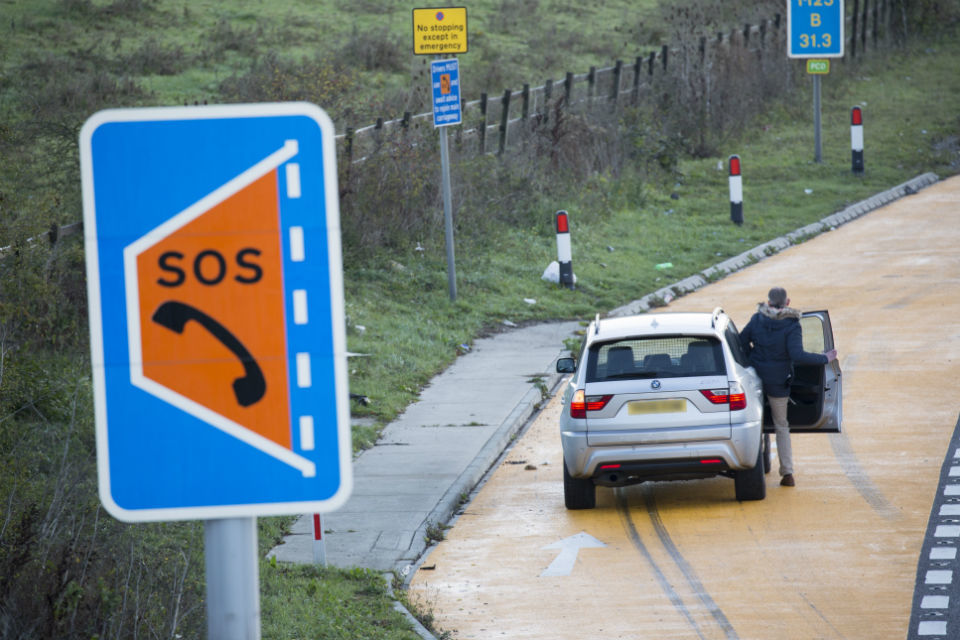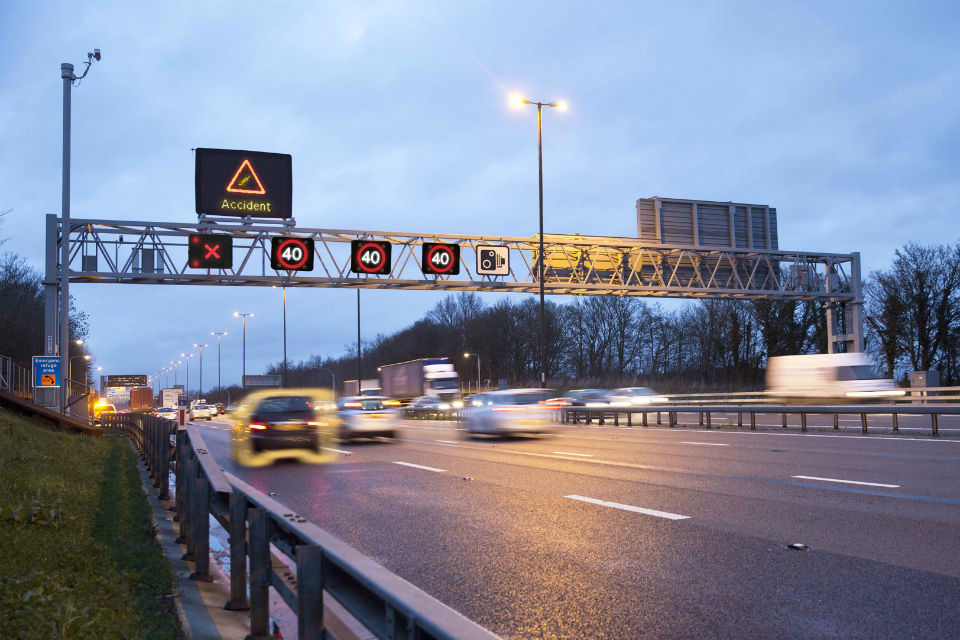How to drive on a smart motorway
How to drive safely and legally on England's smart motorways.
Visit our motorways campaign page.
Many parts of Highways England’s motorway network use technology to monitor and manage the flow of traffic. The technology is controlled from regional control centres which can activate and change signs and variable speed limits. This helps keep the traffic flowing more smoothly.
This map shows routes of completed smart motorways and smart motorways under construction.
The three types of motorway shown on the map are:
- Dynamic hard shoulder: where the hard shoulder is temporarily opened up to traffic
- All lane running: where the full width of the road is usable with emergency refuge areas alongside
- Controlled motorway: with three or more lanes, a hard shoulder and variable speed limits
On some busier sections of motorways we temporarily open the hard shoulder or have converted it to a permanent extra lane so that more vehicles can travel, avoiding the expense and disruption of widening the road.
These technology-enabled sections of motorways have enhancements such as:
- electronic message signs that display Red X signs and variable speed limits
- sensors to monitor traffic volumes
- CCTV cameras
- emergency areas, with emergency roadside telephones
Video: how to drive on a smart motorway
Quick tips
- Never drive in a lane closed by a Red X.
- Keep to the speed limits shown on the signs.
- A hard shoulder is always identified by a solid white unbroken line - if there’s no speed limit displayed above it or a Red X is displayed, do not use it except in emergency.
- A broken white line indicates a normal running lane.
- If the hard shoulder is being used as an extra lane, use the designated emergency areas for emergencies.
- If your vehicle experiences difficulties, eg warning light, exit the motorway immediately, if you can.
- If you break down, put your hazard lights on.
- Most breakdowns are preventable - keep your car well maintained, check your tyres and make sure you have enough fuel for your journey.
Video playlist: Highways England vehicle checks

Smart motorway emergency area
Breaking down on a motorway
Knowing what to do in an emergency or a breakdown is key to keeping yourself and others safe.
If your vehicle has a problem on a motorway with no hard shoulder:
- Move into the left hand lane and put your hazard lights on
- Exit at the next junction or services OR
- Follow the orange SOS signs to an emergency area and call for help using the free telephone. This will tell us your location.
If you can’t get off the motorway or to an emergency area:
- Move your vehicle as close as possible to the left-hand verge, boundary or slip road
- If you feel you can get out safely with any occupants, consider exiting your vehicle via the left-hand door, and wait behind the safety barrier if there is one and it is safe to do so. Keep clear of your vehicle and moving traffic at all times
- Call 999 immediately
If your car stops unexpectedly in any lane and it is not safe to get out
- Keep your seatbelts and hazard lights on and call 999 immediately
- We’ll close the lane and send help.
If there is a hard shoulder on a motorway, you can use it to stop in an emergency only. If you can, get behind the safety barrier and away from your vehicle and moving traffic. Use the free SOS phone or call Highways England on 0300 123 5000 for help. Why not save the number in your phone now in case you ever need it?
Do not put out a warning triangle in any circumstances.
All motorists should be able to make their own recovery arrangements in the event of a breakdown. We advise you to carry details of your provider with you.
Remember, most breakdowns are avoidable and simple vehicle checks can help you have a safer journey. Check your tyres, fuel, oil and water. However, if your vehicle appears to have problems or is damaged, always try to exit the motorway.
Our control centres
Our regional control centres use CCTV cameras to monitor and manage our motorways. Once they’re aware of your situation (via CCTV or the police), they can set overhead signs and close the lane to help keep traffic away from you.
The control centre can also send a traffic officer or the police to help you, and assist you to rejoin the motorway when appropriate.
Please note that if you break down or are in an emergency, you must call for help as soon as possible.
Essential items to keep in your vehicle
Keep the following items in your vehicle in case you break down:
- warm clothes
- hi-vis jacket
- breakdown cover details
- charged mobile phone
- access to a route planner either via your smart phone or an atlas
- water and food
- a torch
- any medication you need
Red X
A Red X sign indicates that a lane is closed to traffic. You must stay out of that lane as there may be an incident or people working ahead, and we may need to keep the lane clear to provide access for maintenance or emergency services.
A Red X can be displayed on gantry signs above each lane or on large signs above the nearside (left hand) of the carriageway.
It’s illegal to drive in a lane closed by a Red X sign. If you’re caught, you could receive a fixed penalty of up to £100 and three points, and in some cases more severe penalties or a court appearance. It’s the responsibility of the police to enforce Red X offences.
For your own safety and the safety of others, never drive in a lane closed by a Red X sign (unless instructed to do so by the police or those instructed by the police, such as our traffic officers).
Please see The Highway Code (Rules 258, 269) for details.
Video: Smart motorways: Red X:
Hard shoulder use and emergency areas
A hard shoulder is always clearly identified with a solid white unbroken line.
On some busier sections of our motorways, we open the hard shoulder to traffic temporarily. If the hard shoulder is open for use, you’ll see a speed limit displayed above it.
If there’s nothing displayed above it, or a Red X is displayed, then you should only use the hard shoulder in an emergency. We only open a hard shoulder when it’s safe to do so. Remember to be vigilant and be aware of breakdowns or stationary vehicles ahead.
On sections of the motorway where the hard shoulder has been converted into a permanent extra lane, this is marked with a broken white line.
Emergency areas are spaced regularly and are clearly marked with blue signs featuring an orange SOS telephone symbol.
If possible, always try to get to an emergency area, even if the hard shoulder is not open to traffic. Emergency areas are set back from the carriageway and provide better protection than the hard shoulder.
You should only use emergency areas in emergencies.
Please see The Highway Code (Rules 264, 269) for details.
Video: Smart Motorways - Emergency Refuge Areas
Variable speed limits
We sometimes vary the speed limit on certain sections of motorway to help steady the flow of traffic and reduce ‘stop-start’ traffic jams.
Variable speed limits can be set at busy times, in conjunction with a Red X sign or to manage a hazard or incident. They can also be automatically triggered by sensors that monitor traffic flow.

Smart motorway gantry showing Red X
A speed limit displayed inside a red circle is legally enforceable. If you go over the speed limit, you’re breaking the law and could receive a fine. We’ll let you know when it no longer applies by setting the national speed limit sign.
If no speed limits are displayed then the national speed limit applies. When speed limits are displayed, they remain in place until notified that they have ended, or a different speed limit is displayed.
Speed cameras are in operation on our motorways. The police are responsible for enforcing speeding offences.
Always drive to a safe speed according to the conditions and be aware of your stopping distances.
Please see The Highway Code (Rule 261) for details.
Keep left
When you’re driving along a motorway you should keep left unless you’re overtaking, no matter how many lanes a motorway has.
It’s a simple rule of the Highway Code, but one which some drivers don’t always follow. You should always drive in the left-hand lane when the road ahead is clear.
The other lanes should only be used for overtaking slower-moving vehicles. Once you’re safely past them, you should return to the left-hand lane.
You mustn’t drive on the hard shoulder except in an emergency, or if directed to do so by the police, Highways England traffic officers or by signs.
Following the keep-left rule helps the traffic flow and avoids frustration with lane-hoggers, so we all have a safer, smoother journey.
Please see The Highway Code (Rule 264) for details.
Campaign materials
If you’d like to support our safety messages, please use these resources.
Updates to this page
-
Updated breakdown information
-
Added links to Highway Code
-
New motorways campaign leaflet added
-
Updated text and campaign materials
-
Text has been updated
-
Updated version of 'When to use a hard shoulder' document added
-
'When to use a hard shoulder' leaflet added
-
'Driving safely when you see a red X sign’ document has been replaced with updated version.
-
Interactive leaflet added
-
Overview video added.
-
First published.